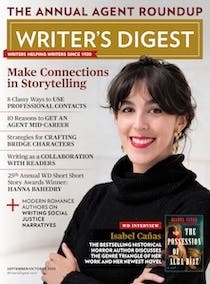Writer’s Digest Columns: Your Story
Want to see your work published in WD? Here are editor tips on how to write a winning Your Story entry.
Now in its 111th rotation (and counting), the WD’s Your Story contest proves to be quite popular, receiving hundreds of entries each time.
The Your Story contest format rotates back and forth between a 650-word short story and single-sentence opening line to a story. For both types of contests, the editors of WD select a photo prompt to inspire the story and select finalists for readers to vote on to pick the winner or winners that will appear in the print edition of WD. You can find this photo prompt both in the current issue of WD and at writersdigest.com/wd-competitions/your-story.
Because the contest is so popular, WD readers have requested some insider secrets of how to write a winning entry. While there is no secret formula, we’ve come across some patterns when reviewing entries that we thought would be helpful to share.
As with any story you submit anywhere, be sure to read and follow the submission guidelines carefully. Editors include certain specifications in the guidelines for a reason.
For example, our Your Story submission guidelines state to paste your entry in the body of the email and use the Your Story contest number as the subject line. We sometimes have multiple contests open for submission at the same time, so if an entry doesn’t follow these guidelines, we’re left to guess which contest the writer is trying to enter.
Our other submission guidelines state to include your name and mailing address with your entry (so we know who to credit the story to and where to mail the winner’s free copy of the WD issue that it appears in).
Sometimes, not following submission guidelines can disqualify your entry. For our one-sentence story prompt, if the entry is any longer than one sentence, we won’t consider it as a finalist. Nor will editors consider an entry that uses poor grammar or punctuation. Likewise, any short story longer than 650 words won’t be able to fit on the pages of our magazine.
Be sure to check whether the contest you are entering is asking for a full 650-word story or just the opening line to a story. Writing the opening line only of a story is a bit different from writing a full 650-word story, so here is a breakdown of Your Story tips for each type of entry:
One-Sentence Stories
Don’t just describe what is in the photo. Every other reader is looking at the same photo, and if you simply describe what you see, chances are your entry will look pretty similar to at least 100 other contest entries.
Leave a little room open for interpretation, but not too much. Make an attempt to tell readers why or how the subject of the photo prompt ended up in that situation. For example, for our Your Story #100 contest that featured an elderly woman in a police lineup, an example of an entry that leaves too much unsaid is “Standing in the police lineup, Margie was able to start checking items off her bucket list.” This doesn’t tell readers what exactly Margie was checking off her bucket list that landed her in the police lineup.
Stand out with your entry. By this, we don’t mean to use a fancy font or all caps. But we tend to favor the entries that interpret the scene a little differently than most of the other entries. When reviewing the entries, I notice after reviewing a few dozen that there are a few common responses that most of the entries will resemble. For example, most of the entries for the Your Story #96 contest that featured a police car photo prompt told stories of violence against women. So, the entries that interpreted the lights on the car as spaceship lights and told stories about aliens caught my eye.
650-Word Stories
Have a strong opening that pulls readers in. But at the same time, you need to provide enough details to give readers a clue of what is going on. If the first few paragraphs are too ambiguous or confusing, you could leave readers lost and risk your entry being passed on. Story openings should provide enough information to paint some part of the picture, even if the rest is to come.
Don’t switch back and forth between verb tenses. It’s confusing, and one of those poor grammar mistakes that tells editors to move on to the next entry.
Don’t just summarize events, or tell a story entirely in a dialogue between two characters. Readers don’t want a story that goes a little like: “This, happened, then this happened, and now we’re here.” If something is a major part of the plot, such as an epic battle to save the princess from the dragon, chances are readers would much rather see this story playing out through some strong scene-building, sensory details, and action than to hear a third-person narrator or another character recount the events of the story as if they were recounting what they ate for breakfast.
Don’t wait until the last paragraph to make the story exciting. There’s nothing wrong with a twist ending to a story, but expect readers to get bored if that’s the only interesting part of the story and they must read paragraphs of fluff to get to it. Try avoiding the cliché “It was all a dream” twist ending. We’ve seen it far too many times.
The same rules of all good flash fiction apply to Your Story. Our photo prompt is just that—an inspiration. Use it to set you on the path of plotting and writing a great story, but don’t let it limit where your creativity might take you.
Are you ready to enter the Your Story contest? Visit writersdigest.com/wd-competitions/your-story to see the latest photo prompt.



